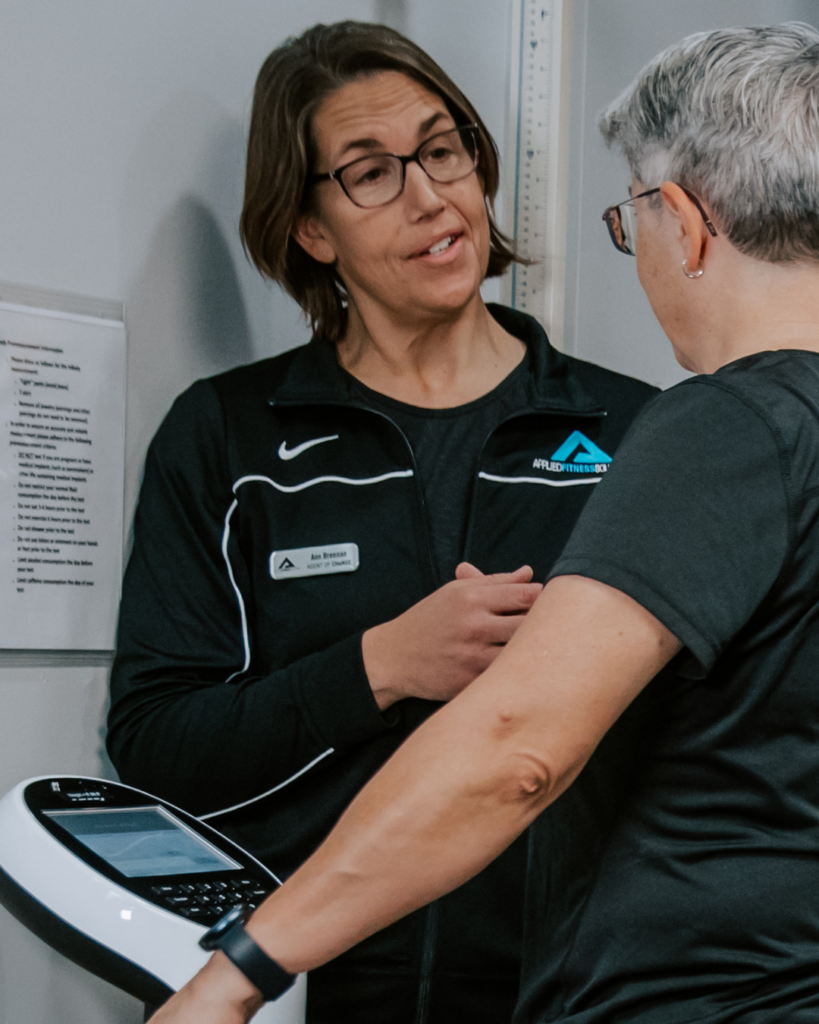As anti-obesity medications (AOMs) like GLP-1 receptor agonists become increasingly popular for managing weight, many individuals integrating these medications into their health regimes have begun to wonder about their effects on muscle mass, especially when combined with strength training. If you’re among those pondering, “Am I losing muscle on my GLP-1?”—this article is tailored for you.
Understanding Anti-Obesity Medications
First, let’s break down how AOMs work. Essentially, these medications mimic certain hormones in the body that help manage blood sugar levels. They increase the release of insulin, reduce the secretion of glucagon (a hormone that raises blood sugar), and slow down the process of stomach emptying, which helps you feel full longer. If you’re really interested in how weight loss medications work we did a full deep dive on the topic. If you’re really interested in how weight loss medications work we did a full deep dive on the topic.
Overall the primary aim of these medications is to help you feel fuller longer, reducing overall caloric intake, and thereby causing weight loss. However, the question arises: does this caloric reduction impact muscle mass?
Muscle Loss is a Normal Part of Weight Loss
When you decide to lose weight (using AOMs or not), understanding that muscle loss often accompanies fat loss is crucial. This phenomenon is a standard part of the weight reduction process, influenced primarily by the body’s need to adapt to a decreased caloric intake. In the realm of weight loss, it’s typical for muscle to comprise about 20% to 30% of the total weight lost. This occurs because the body, when faced with a caloric deficit, not only targets fat stores for energy but also muscle protein, particularly when dietary nutrients are insufficient to meet its energy requirements.
The extent of muscle loss during weight loss can vary significantly based on several key factors. The size of the caloric deficit plays a crucial role; larger deficits prompt the body to rely more heavily on muscle protein as an energy source, potentially increasing muscle loss. Additionally, the protein content of one’s diet is equally important. Diets that are low in protein lead to greater muscle degradation because the body lacks the essential amino acids needed for muscle maintenance and repair.

Focusing on Muscle Function, Not Just Muscle Loss
While muscle loss is an inevitable part of weight loss, whether through calorie restriction or AOMs like GLP-1 agonists, the more significant issue at hand is not just the reduction in muscle mass but the potential decline in muscle function. This includes aspects like muscle strength, power, and endurance, which are crucial for maintaining overall health and physical performance.
The decline in muscle function can have a more profound impact on your health than the mere loss of muscle mass. Muscle strength is essential for daily activities, from lifting objects to climbing stairs. Similarly, muscle power affects your ability to perform tasks quickly and efficiently, while endurance is crucial for sustaining activities over time. When these aspects of muscle function are compromised, it not only affects physical capabilities but also increases the risk of injuries and decreases quality of life.
When using AOMs, the concern needs to shift from whether muscle mass is being lost to how these losses might affect muscle function. Since muscle loss can be a byproduct of the caloric deficit these medications encourage, it’s essential to consider how this might translate into weakened muscle strength or reduced endurance. The real issue isn’t necessarily the loss of muscle tissue itself—since this is a natural response to weight loss—but rather ensuring that the loss does not impair muscle function.
Again, it’s important to remember that while muscle loss is a common occurrence during any weight loss regime, the key issue to monitor is the potential decline in muscle function. This aspect is crucial for maintaining overall health and physical independence, making it essential to address muscle function explicitly in any weight loss plan, particularly when using anti-obesity medications.
Optimizing Muscle Function with Strength Training on AOMs
Integrating strength training into your routine while using AOMs such as GLP-1 receptor agonists is essential for enhancing muscle function, which includes strength, power, and endurance. This focus is crucial because maintaining robust muscle function is vital for overall health and can dramatically improve the quality of life, especially during weight loss efforts.
One of the key strategies for boosting muscle function is to prioritize multi-joint exercises. Engaging in exercises that involve multiple joints and muscle groups, such as squats, bench presses, and rows, is effective at improving overall muscle strength and functional capacity. These types of exercises make everyday activities easier and reduce the risk of falls or injuries. Additionally, incorporating power training is beneficial. This involves performing movements at a high velocity to improve the muscle’s ability to exert force quickly. Exercises like body weight speed squats or medicine ball throws are excellent for enhancing muscle power, which is particularly important as it declines naturally with age.

Another important aspect of strength training is building endurance with resistance training. Low to moderate intensity resistance training with higher repetitions can increase muscle endurance. This type of training enhances the muscle’s ability to perform activities over prolonged periods without fatigue, crucial for overall stamina and health. To continuously challenge the muscles and improve their function, it is advisable to vary your routine every couple of months. This can mean changes in the types of exercises, the order of exercises, resistance levels, or the number of repetitions and sets.
Focusing on progressive overload is also essential. Gradually increasing the weight, frequency, or number of repetitions in your exercises will challenge the muscles and lead to improvements in muscle function. This principle is essential for continuing to make gains in strength, power, and endurance over time. Ensuring adequate recovery is vital to allow muscles to repair and grow stronger. Ensuring sufficient rest between strength training sessions, especially for the same muscle groups, is particularly important when in a calorie deficit that limits recovery.
Monitoring your progress is crucial to ensure that your strength training routine is effectively enhancing muscle function. Regular assessments can help identify areas that need more focus or adjustments in your workout intensity or volume, particularly in response to how your body reacts to AOMs. By focusing on improving muscle function through tailored strength training while on anti-obesity medications, you not only support your weight loss goals but also enhance your overall physical capabilities, ensuring that you remain strong and functional throughout your weight management journey. Check out how we ensure this happens via our Exercise Physiologist led workouts.

Strength Training: Empowering Your Muscle Function During Weight Loss with AOMs
As we navigate the complexities of weight loss with anti-obesity medications like GLP-1 receptor agonists, it’s crucial to remember the significant role that strength training plays in enhancing muscle function. This journey isn’t just about shedding pounds; it’s about empowering your body to be stronger, more capable, fully functional, and in control of your own health even as you work towards your weight loss goals.
Strength training, when tailored to your needs, acts not just as a tool for maintaining muscle mass, but as a fundamental component that enhances muscle strength, power, and endurance. These elements are essential for everyday activities and overall quality of life. By prioritizing exercises like squats, bench presses, and rows, and incorporating power training and endurance workouts, you are taking proactive steps to ensure that your muscles remain robust and resilient.
Moreover, adapting your routine to include a variety of exercises and focusing on progressive overload are critical strategies to keep advancing in your fitness journey. Regularly monitoring your progress and adjusting your training regimen in response to your body’s reactions to AOMs are key to ensuring that the physical changes you experience are truly beneficial. This approach not only supports your weight loss ambitions but significantly enhances your overall physical capabilities.
Remember, while muscle loss may be a natural part of the weight loss process, the decline in muscle function is not inevitable. With the right strategies in place, you can maintain—and even improve—your muscle function, ensuring that every step you take towards weight loss is also a step towards a healthier, more vibrant life. Let this journey be one of transformation, not just in how much you weigh, but in how strong, powerful, and capable you feel every single day.
If you’re on a GLP-1 and want to ensure you’re not just losing weight—but gaining strength, confidence, and control—our My180 Program was built for you. It’s a six-month, high-accountability coaching experience led by a Registered Dietitian, Exercise Physiologist, and dedicated Health Coach who understand exactly how to navigate muscle loss, GLP-1 strength training, and everything in between. Whether you’re asking “Does GLP-1 cause muscle loss?” or “How do I protect my strength while on medication?”—My180 gives you the strategy, support, and structure to thrive.
About the Author:
-

Michael Stack is the founder & CEO of Applied Fitness Solutions and Frontline Fitness Pros. He is a faculty lecturer for the University of Michigan’s School of Kinesiology. He is also the creator and the host of the Wellness Paradox Podcast, produced in conjunction with University of Michigan.
Michael is an exercise physiologist by training and a health entrepreneur, health educator, and fitness industry advocate by trade. He is dedicated to enhancing the standard of practice of, and advocating for, fitness and wellness professionals to ensure they become an essential constituent in the healthcare delivery system.
With a career spanning over three decades in fitness, health, and wellness Michael has a deep knowledge of exercise physiology, health/wellness coaching, lifestyle interventions to mitigate chronic disease and leadership. He is credentialed through the American College of Sports Medicine (ACSM) as an Exercise Physiologist (ACSM-EP), Exercise is Medicine practitioner (ASCM-EIM), and a Physical Activity in Public Health Specialist (ACSM-PAPHS). Michael is a National Strength & Conditioning Association (NSCA) Certified Strength & Conditioning Specialist (CSCS), and a CDC Diabetes Prevention Program (DPP) Lifestyle Coach.
Michael received his undergraduate degree from the University of Michigan’s School of Kinesiology in 2004 and is currently a Master’s of Public Health (MPH) candidate at University of Michigan, with a specific concentration in health behavior and health education.
Michael is a board of directors’ member for the Physical Activity Alliance and Michigan Fitness Clubs Association. He sits on the University of Michigan’s School of Kinesiology Alumni Board of Governors. Michael is an expert curriculum reviewer for the American College of Lifestyle Medicine. Finally, he is a member of the executive leadership team for American Heart Association’s Heart Walk.
Michael lectures nationally for several health/fitness certification and continuing educations, including; IHRSA, the Medical Fitness Association, the National Strength & Conditioning Association, and SCW Fitness.
